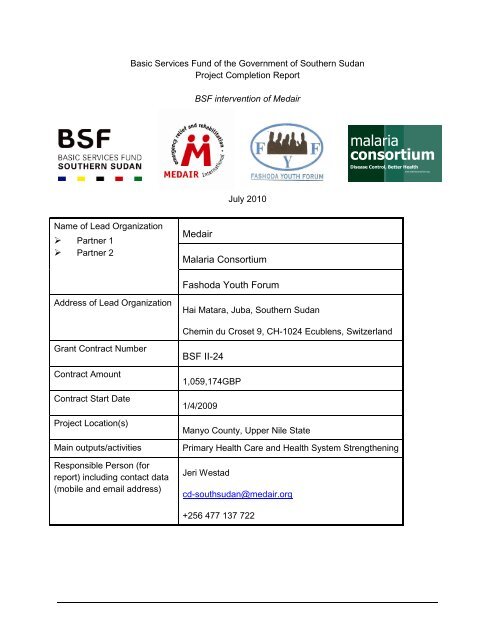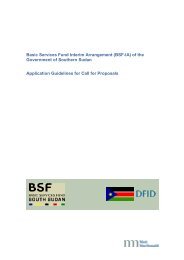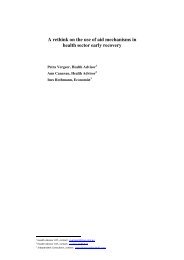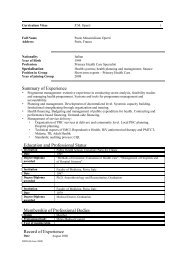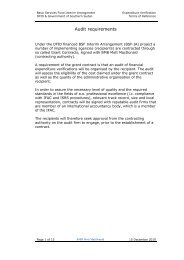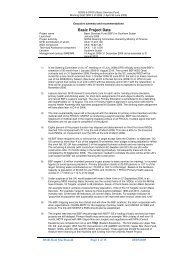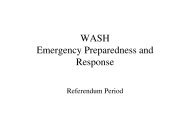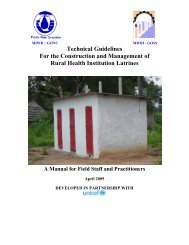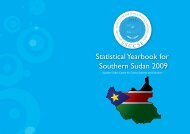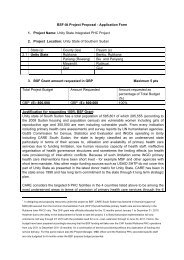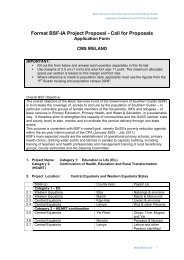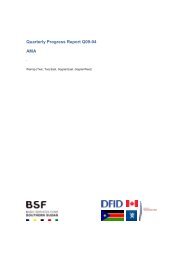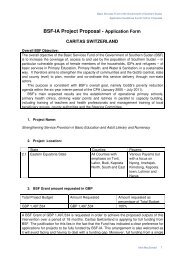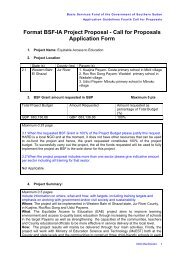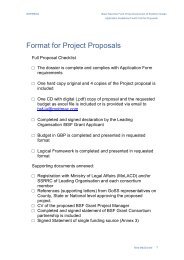MEDAIR Completion Report - Basic Services Fund SOUTH SUDAN
MEDAIR Completion Report - Basic Services Fund SOUTH SUDAN
MEDAIR Completion Report - Basic Services Fund SOUTH SUDAN
Create successful ePaper yourself
Turn your PDF publications into a flip-book with our unique Google optimized e-Paper software.
<strong>Basic</strong> <strong>Services</strong> <strong>Fund</strong> of the Government of Southern Sudan<br />
Project <strong>Completion</strong> <strong>Report</strong><br />
BSF intervention of Medair<br />
malaria<br />
consortium<br />
Disease Control, Better Health<br />
www.malariaconsortium.org<br />
July 2010<br />
Name of Lead Organization<br />
Partner 1<br />
Partner 2<br />
Medair<br />
Malaria Consortium<br />
Fashoda Youth Forum<br />
Address of Lead Organization<br />
Hai Matara, Juba, Southern Sudan<br />
Chemin du Croset 9, CH-1024 Ecublens, Switzerland<br />
Grant Contract Number<br />
Contract Amount<br />
Contract Start Date<br />
Project Location(s)<br />
Main outputs/activities<br />
Responsible Person (for<br />
report) including contact data<br />
(mobile and email address)<br />
BSF II-24<br />
1,059,174GBP<br />
1/4/2009<br />
Manyo County, Upper Nile State<br />
Primary Health Care and Health System Strengthening<br />
Jeri Westad<br />
cd-southsudan@medair.org<br />
+256 477 137 722
BSF Project <strong>Completion</strong> <strong>Report</strong> of Medair Version 1 (July 2010)<br />
Executive Summary Recommendations<br />
Working as a consortium, Medair, the Malaria Consortium, and Fashoda Youth Forum (a<br />
national NGO) delivered a new primary health care and health system strengthening project in<br />
2009-10. The project provided support for MoH provision of primary health care at two PHCCs<br />
and two PHCUs in two payams of Manyo County which had not received previous NGO support<br />
for health care. The consortium approach brought expertise in building capacity at every level:<br />
from the grassroots community (FYF) to health facility level (Medair) and county/state level<br />
(Malaria Consortium). The objective of the project was threefold: to increase communities’<br />
access to primary health care (through improvement of health infrastructure, expansion of the<br />
PHC services available, and increased community awareness); to increase the sustainability of<br />
services (through strengthening the State Ministry of Health and County Health Department,<br />
and increasing community participation in and ownership of PHC services); and to improve PHC<br />
service range and quality in line with the <strong>Basic</strong> Package of Health <strong>Services</strong> (through staff<br />
training and provision of drugs and equipment).<br />
During the project period, 28,422 beneficiaries have benefited directly from the basic health<br />
services provided (including 26,098 people attending for outpatient care, 864 children under five<br />
years receiving DPT3, 1,245 pregnant women attending for antenatal care, and 215 mothers<br />
delivering their babies in health facilities). Three new health facility buildings have been<br />
constructed in partnership with the County Authority. Community members have been<br />
nominated and trained to form village development committees or management committees to<br />
support the four supported health facilities. Community members (VDC and Management<br />
Committee members, health and hygiene promotion supervisors and volunteers, and traditional<br />
birth attendants) have received 825 days of formal training. Health facility staff (including<br />
medical assistants, nurses, midwives, lab technicians and cleaners) has received 1,304 days of<br />
formal training, and members of the CHD have received 36 days of formal training.<br />
Members of the consortium have encountered encouragements and challenges during<br />
implementation of this new project. At county level, the County Authority and CHD have<br />
demonstrated significant commitment. The County Authority have met the costs of labour for the<br />
majority of construction work for three new health facility buildings and provided 50% of the<br />
monthly recurrent budget for each health facility. The CHD, especially the County Medical<br />
Officer, have been active in staff management and more recently in supervision. However,<br />
relying on the County Authority to fund labour has caused significant delays to progress, and<br />
required persistence and constant advocacy. CHD members have varied in their commitment,<br />
citing lack of funds as a major constraint to their activities. The CHD have been disappointed by<br />
the lack of financial support from the County Authority and SMoH; having worked hard to<br />
produce a realistic annual workplan and budget, their requests for support were rejected by both<br />
bodies. At health facility level, redeployment of staff between health facilities by the CHD every<br />
six months has been challenging to continuity of programming, especially for staff training.<br />
However, the CHD felt that staff rotation was necessary to ensure all staff had opportunity to<br />
benefit from in-service training and incentives available at Medair supported facilities. (Formal<br />
Medair trainings are also open to staff working at facilities not receiving support.) At community<br />
level, a high level of dependency has been encountered. Community members have been<br />
Medair 1.
BSF Project <strong>Completion</strong> <strong>Report</strong> of Medair Version 1 (July 2010)<br />
reluctant to recognize their own capacity to address problems, and have demanded incentives<br />
and equipment from members of the consortium. At all levels, language and literacy have been<br />
problematic. The majority of the population (including health facility staff and local government)<br />
do not speak, read or write English, and many do not read or write Arabic.<br />
These challenges suggest several recommendations for decision makers:<br />
At donor level,<br />
• Inclusion within donor policy of a requirement for local government contribution/participation<br />
in projects would reinforce NGO efforts on the ground. (A visit from a representative of the<br />
Joint Donor Office during this project period was very helpful. The representative met with the<br />
County Authority, SSRRC and CHD and emphasized the need for the County Authority to<br />
contribute and honour its commitments.)<br />
At national level,<br />
• Development of clear guidance on the roles, responsibilities and especially support of the<br />
CHD are essential to direct capacity building activities appropriately, and to leverage county<br />
and state level support for CHDs.<br />
• Development of Arabic language and/or pictoral job aids (such as PHCC/PHCU Treatment<br />
Guidelines, patient registration books, and MoH reporting forms) will be necessary to<br />
effectively roll out national management protocols and HMIS in areas of low English literacy.<br />
In the longer term, improving child and adult fluency and literacy in English will require<br />
significant input from the education sector.<br />
Members of the consortium have identified and addressed internal weaknesses during the<br />
project period. Medair, as lead agent, has found working in consortium both positive and<br />
challenging. The importance of coordination between partners at field, county and national level<br />
has become clear, to ensure a common approach with authorities and the community, and to<br />
avoid duplication of efforts. Coordination has improved during the project period as more formal<br />
coordination mechanisms (including regular meetings) have been established in response to<br />
earlier difficulties. Working with a national NGO has been rewarding, but the level of support<br />
and supervision required was initially underestimated, and has been increased during<br />
implementation. The Malaria Consortium has seen the importance of involving the SMoH,<br />
County Authority and community leaders in the planning of project approach and activities, and<br />
of giving feedback to these bodies during and after implementation. They have also increased<br />
the amount of time spent by field staff in location, in recognition of the need for in-service<br />
coaching and follow up of formal trainings. Fashoda Youth Forum have recognized the need to<br />
support their relatively inexperienced colleague in the field with increased input from their<br />
technical and management team.<br />
Medair 2.
BSF Project <strong>Completion</strong> <strong>Report</strong> of Medair Version 1 (July 2010)<br />
Table of Contents<br />
Introduction.................................................................................................................4<br />
Background.................................................................................................................5<br />
The BSF intervention..................................................................................................6<br />
Finance ...................................................................................................................... 13<br />
Annex A. Logframe.............................................................................................. 15<br />
Annex B: Logframe targets and achievements ................................................. 21<br />
Annex C: Project Staff......................................................................................... 25<br />
Annex D: Final Invoice ........................................................................................ 27<br />
Annex E: Primary Health Information ................................................................ 29<br />
Annex F: Training Tables.................................................................................... 30<br />
Abbreviations<br />
ACSI<br />
BPHS<br />
CHD<br />
CHMT<br />
CHW<br />
EPI<br />
FGD<br />
FYF<br />
HHP<br />
HMIS<br />
HSS<br />
MC<br />
MC<br />
(S)MoH<br />
NFI<br />
PHCC<br />
PHCU<br />
VDC<br />
Accelerated Childhood Survival Initiative<br />
<strong>Basic</strong> Package of Health <strong>Services</strong>*<br />
County Health Department<br />
County Health Management Committee<br />
Community Health Worker<br />
Expanded Programme on Immunisation<br />
Focus Group Discussion<br />
Fashoda Youth Forum<br />
Health and Hygiene Promotion<br />
Health Management Information System<br />
Health System Strengthening<br />
Malaria Consortium<br />
Management Committee<br />
(State) Ministry of Health<br />
Non Food Items<br />
Primary Health Care Centre<br />
Primary Health Care Unit<br />
Village Development Committee<br />
* Please note that where the BPHS is mentioned, the reference is to the third version of the document.<br />
Medair 3.
BSF Project <strong>Completion</strong> <strong>Report</strong> of Medair Version 1 (July 2010)<br />
Introduction<br />
This Medair-led Primary Health project ran from 01 April 2009 to 30 June 2010, with a budget of<br />
1,059,174 GBP funded by BSF-II.<br />
A total of 27,185 people living in Wadekona and Kaka payams of Manyo County were targeted<br />
in this project. A total of 28,422 beneficiaries have benefited directly from the basic health<br />
services provided during this project period. This includes 26,098 people attending for outpatient<br />
care, 864 children under five years receiving DPT3, 1,245 pregnant women attending for<br />
antenatal care, and 215 mothers delivering their babies in health facilities.<br />
88% of the 32 project activities which were planned to achieve four key results have been<br />
achieved. This includes 95% of activities related to support for four health facilities, 79% of<br />
activities related to improved community health and hygiene practices, 81% of activities related<br />
to building community capacity to support health services, and 87% of activities to build the<br />
capacity of the CHD and SMoH.<br />
Training and capacity building has been delivered at community, health facility, county and state<br />
level. Community members (VDC and Management Committee members, health and hygiene<br />
promotion supervisors and volunteers, and traditional birth attendants) have received 825 days<br />
of formal training. Health facility staff have received 1,304 days of training, members of the CHD<br />
have received 97 days of formal training, and SMoH staff have received 36 formal training days.<br />
The project was implemented by a consortium of NGOs. Medair acted as lead agent, with the<br />
Malaria Consortium and Fashoda Youth Forum as co- and sub- recipients respectively. The<br />
consortium approach allowed each partner to work to their strengths, ensuring that the overall<br />
project benefited from expertise at community, health facility and county level. Coordination<br />
between partners was challenging initially, but has improved during the project period. Working<br />
in partnership with a national NGO has been rewarding but has required significant input.<br />
Medair 4.
BSF Project <strong>Completion</strong> <strong>Report</strong> of Medair Version 1 (July 2010)<br />
Background<br />
Project and Consortium Background<br />
Medair has a strong working relationship with Upper Nile SMoH based on 7 years of ongoing<br />
support to PHC services in the state, including support for BPHS implementation in adjacent<br />
Melut County since 2007. In 2008 the SMoH approached Medair for support in rolling out the<br />
BPHS in Manyo County.<br />
In late 2008, Medair applied for funding through BSF-II; the contract was signed in April 2009.<br />
Having learnt from experience implementing as a lone NGO in Melut County, Medair<br />
approached Malaria Consortium and Fashoda Youth Forum to form a consortium. Medair<br />
recognized the value of complementing Medair’s extensive experience of working at health<br />
facility level with MC’s expertise in health systems strengthening and previous work with the<br />
Upper Nile SMoH, enlisting their support to build the capacity of the CHD and SMoH. Medair<br />
had partnered with Fashoda Youth Forum during an emergency NFI intervention in 2007, and<br />
noting the organisation’s previous experience implementing HHP projects, requested their<br />
support with HHP in Manyo County.<br />
Project design was informed by lessons learnt from implementation in Melut County. As a result,<br />
Medair’s approach to this project was modified in several ways. Activities were planned and<br />
implemented to complement and build on existing MoH structures and service provision. No<br />
additional health facility staff were employed, and the CHD have retained control of health<br />
facility staffing levels and advocacy for additional staff from the SMoH. Additional services have<br />
been introduced only after consideration of their sustainability without NGO support. Extensive<br />
entry workshops were held in each community, and a county-level MoU was signed before<br />
implementation started, clearly stating the commitments of Medair and of the County Authority.<br />
NGO visibility has been kept low, and community ownership of health facilities has been<br />
encouraged through County Authority contribution to health facility construction, and early set<br />
up of VDCs and management committees.<br />
Medair’s activities in Manyo County were intended to be multi-sectoral, and include WASH<br />
interventions in communities with supported health facilities. Unfortunately, due to delayed<br />
release of funding from other donors, WASH implementation was delayed until Q1 2010.<br />
Context<br />
Upper Nile State has historically been a marginalised area of Southern Sudan suffering<br />
isolation, illiteracy, inter-tribal/inter-factional fighting, and low community organisation. Poor<br />
county and state infrastructure results in high transport costs and considerable difficulties in<br />
accessing some health facilities during the rainy season. Manyo County was prioritised by the<br />
SMoH as the area in most need of external support in Upper Nile State. Low levels of access to<br />
healthcare were demonstrated in a 2008 survey finding only 13% vaccination coverage<br />
according to the MoH vaccination schedule (for BCG, DPT and measles) among children in<br />
Manyo County.<br />
Medair 5.
BSF Project <strong>Completion</strong> <strong>Report</strong> of Medair Version 1 (July 2010)<br />
The BSF intervention<br />
Project Beneficiaries<br />
Q2 2009 Q2 2010<br />
Total<br />
Q2 2009 - Q2 2010<br />
Number of first consultations Data not available 6,561 26,098<br />
No of children under 5 years that received DPT3 18 201 864<br />
No of first antenatal care visits Data not available 386 1,245<br />
No of deliveries at facility Data not available 75 215<br />
Total direct beneficiaries Data not available 7,223 28,422<br />
Project activities and achievements<br />
Activities<br />
Achievements over Project Period<br />
%<br />
Comments<br />
Achieved<br />
Result 1.1. Health Service Delivery - Medair has provided support to two PHCCs and two<br />
PHCUs (Wadekona and Kaka payams) throughout the<br />
project period. Support given has included financial<br />
incentives for staff, formal and on-the-job training,<br />
supervision, top-up of MoH drugs and supplies, provision<br />
of medical equipment and furniture, construction and<br />
maintenance of health facilities, and provision of recurrent<br />
budgets.<br />
Support delivery of BPHS according to full package of<br />
MoH standards and service profiles in Medair supported<br />
facilities in Manyo<br />
70% 69% of BPHS key activities (85% PHCUs; 62% PHCCs)<br />
and 71% of the BPHS service profile (65% PHCUs; 77%<br />
PHCCs) have been supported. <strong>Services</strong> not supported<br />
include assisted deliveries, dental care, and management<br />
of malnutrition at PHCU level; the low level of qualification<br />
of heath facility staff has not allowed safe introduction of<br />
Improve structures of 2 PHCUs and 2 PHCCs in Manyo<br />
County<br />
these services.<br />
100% New four-room buildings have been constructed at one<br />
PHCC and two PHCUs. Medair has provided construction<br />
Medair 6.
BSF Project <strong>Completion</strong> <strong>Report</strong> of Medair Version 1 (July 2010)<br />
Work with local authorities and MoH to redistribute health<br />
staff to ensure all clinics adequately staffed according to<br />
BPHS standards<br />
Ensure regular and sufficient supply of appropriate drugs<br />
and medical supplies to supported health facilities.<br />
Ensure up-to-date protocols, in line with MoH and<br />
international standards, are available and in use in all<br />
facilities.<br />
Establish and maintain a health management information<br />
system in all facilities, including staff training<br />
Distribute mosquito nets through both targeted (500 via<br />
EPI and ANC) and mass distribution campaigns<br />
materials and the County Authority has paid for the<br />
majority of the labour. Materials have been procured for<br />
construction of a new two-room building at the remaining<br />
PHCC, but the County Authority has not yet provided the<br />
labour. Rehabilitation of existing buildings has also been<br />
carried out at two PHCCs. Latrines have been provided at<br />
all facilities.<br />
100% During Q2 2009 Medair worked with the CHD to ensure<br />
adequate staffing at all facilities. Staff have been rotated<br />
between facilities every six months by the CHD, and<br />
staffing numbers have remained adequate. All staff are<br />
employed by the SMoH or County Authority.<br />
100% MoH PHCU drug kits were distributed in Q3 and Q4 2009,<br />
although the contents were insufficient to meet facilities’<br />
needs and did not include items needed for the PHCCs.<br />
Medair has supplied drugs in line with the Essential Drugs<br />
List and MoH drug kit lists to ensure adequate stock levels<br />
at all facilities throughout the project period. Malaria<br />
Consortium distributed protective pharmaceutical boxes to<br />
PHCUs selected on the basis of findings from health<br />
facility mapping.<br />
100% Health facility staff received training on MoH PHCC and<br />
PHCU guidelines in Q3 2009, with in-service coaching<br />
throughout the project period. Copies of these guidelines<br />
are available in all facilities. Arabic translations of drug<br />
dosage guidelines were prepared and distributed in Q4<br />
2009 in response to the staff’s low level of English literacy.<br />
100% All health facilities have been submitting regular reports<br />
(including IDSR) since Q3 2009. Medair has provided inservice<br />
training and support for staff. Malaria Consortium<br />
has conducted HMIS and IDSR trainings in Q2 2010.<br />
100% 2,502 LLINs have been distributed at Medair-supported<br />
facilities through routine EPI and ANC services. Malaria<br />
Consortium coordinated mass distribution of 23,300 LLINs<br />
to 7,716 households as part of ACSI in Q2 2010.<br />
Medair 7.
BSF Project <strong>Completion</strong> <strong>Report</strong> of Medair Version 1 (July 2010)<br />
Conduct monthly supportive supervision visits to PHCUs<br />
and PHCCs with quarterly joint supervision visits with<br />
CHD member(s)<br />
Support CHD and MOH to develop and deliver referral<br />
services from PHC facilities<br />
Conduct quarterly beneficiary feedback session in each<br />
health facility<br />
Monitor contribution to building institutional capacity and<br />
sustainability by using BISAC tool every 6 months.<br />
Provide training for all health facility staff according to<br />
needs identified in training needs assessment conducted<br />
during inception period<br />
Send 4 health staff on external training for continuing<br />
professional development e.g.<br />
IMA, AMREF, UNFPA<br />
100% Medair has conducted supervision visits to all facilities at<br />
least monthly (subject to access) throughout the project<br />
period. During Q1 and Q2 2010, the CHD have<br />
participated regularly, with at least one joint visit to each<br />
facility each quarter. In Q2 2010, following training from<br />
Malaria Consortium on supportive supervision, the CHD<br />
conducted ten joint supervision visits with Malaria<br />
Consortium to seven health facilities in Wadekona, Kaka<br />
and Kit Gwang payams.<br />
100% Referrals from PHCUs to PHCCs and from PHCCs to the<br />
nearest county hospital (Renk Hospital from Wadekona<br />
and Melut Hospital from Kaka) have been ongoing since<br />
Q2 2009. Local transport is often used, but where<br />
requested Medair has assisted with a boat or vehicle.<br />
60% Workshops to increase community awareness of services<br />
and provide opportunity for feedback were held in Q2 and<br />
Q4 2009 and Q1 2010. Training of VDCs/MCs has<br />
provided a more indigenous and sustainable voice for<br />
community feedback since Q4 2009.<br />
100% Medair conducted internal reviews using the BISAC tool in<br />
early Q4 2009 and late Q1 2010. Team discussion and<br />
findings were used to revise the project approach and<br />
activities where necessary.<br />
100% Health facility staff have received formal refresher training<br />
from Medair and Malaria Consortium according to their<br />
professional background (MAs, nurses, midwives and<br />
cleaners have all received specific training), in addition to<br />
ongoing in-service training. Needs assessment has been<br />
ongoing, with training given in response to needs identified<br />
(e.g. training on management of diarrhoea planned in<br />
response to seasonal increase in diarrhoea cases during<br />
Q2 2010).<br />
100% Two medical assistants attended short term paediatric<br />
training, one medical assistant attended a one-month<br />
EmONC training, and two laboratory technicians attended<br />
short term technical trainings. However, it has been<br />
Medair 8.
BSF Project <strong>Completion</strong> <strong>Report</strong> of Medair Version 1 (July 2010)<br />
Result 1.2 Community Enabled Health<br />
Promotion<br />
Identify and train 60 HHP volunteers and 2<br />
HHP supervisors within local communities<br />
in Payams of Kaka and Wadekona to deliver HHP<br />
activities as outlined in summary table 5 of BPHS (3 rd<br />
version)<br />
Finalize HHP targets and workplan during 3<br />
month inception phase<br />
Implement <strong>Basic</strong> School Health Package in<br />
4 schools in Manyo (2 schools per payam)<br />
Conduct 3 behaviour change workshops on<br />
health topics raised by Focus Group<br />
Discussions for community leaders,<br />
traditional healers and health staff<br />
2.1 Community level training and capacity building<br />
VDCs<br />
Formal MoUs for each health facility signed with local<br />
authorities at County level, MoH and Payam<br />
administrators annually, explicitly outlining Medair versus<br />
external inputs<br />
Training and facilitation of health facility management<br />
committees/Village Development Committees<br />
difficult to help health facility staff access training due to<br />
their low level of English language.<br />
90% Fashoda Youth Forum trained 56 HHP volunteers (14 in<br />
each community served by a Medair-supported health<br />
facility) and two payam HHP supervisors during 2009.<br />
100% Fashoda Youth Forum and Medair finalized the HHP<br />
workplan during Q2 2009.<br />
50% Fashoda Youth Forum conducted Children’s Health and<br />
Sanitation Trainings in one school in Kaka town (25 girls;<br />
25 boys) and one school in Wadekona town (16 girls; 24<br />
boys) in Q2 2010. It was not possible to conduct CHAST in<br />
a second school in each payam due to unforeseen<br />
prolonged closure of schools during and after the election.<br />
67% FYF conducted two FGDs in Kaka payam and one in<br />
Wadekona payam. Information gained was used to inform<br />
two behavior change workshops, held in Kaka (12 female<br />
participants; 16 male) and Wadekona (15 female; 30 male)<br />
in Q2 2010. A third workshop was scheduled for Q2 2010<br />
but community leaders were preoccupied with ACSI<br />
implementation.<br />
100% A community contract (MoU) between Medair and the<br />
County Authority, SSRRC and CHD was signed in Q2<br />
2009. An MoU with the SMoH was also signed in Q2 2009.<br />
100% Medair conducted training for VDCs and MCs for four<br />
health facilities in Q3 and Q4 2009 to increase community<br />
participation in health facility support and awareness of<br />
free services offered.<br />
Medair 9.
BSF Project <strong>Completion</strong> <strong>Report</strong> of Medair Version 1 (July 2010)<br />
Work with County Authority to agree small recurrent<br />
budget for each health facility (approx 5% of MoH<br />
salaries)<br />
Assist CHD to carry out at least one VDC training in each<br />
payam<br />
Train and mentor VDC in supervision and monitoring of<br />
the health facilities<br />
Conduct one leadership and governance training for local<br />
authorities and CHD<br />
Conduct 2 English courses (for health staff , VDC, CHD<br />
and local authorities)<br />
100% The County Authority has been contributing 50% of the<br />
recurrent budget for each health facility since Q2 2009.<br />
50% The CHD participated in Medair VDC training in Kaka<br />
payam in Q4 2009. The CHD members were initially<br />
reluctant, but have become gradually more motivated to<br />
coordinate with VDCs/MCs during Q1 and Q2 2010,<br />
although there has not been an opportunity for them to<br />
participate in a VDC training in Wadekona payam during<br />
this time.<br />
100% The Medair Capacity Building Officer has visited each<br />
VDC/MC at least monthly since their training in Q3 and Q4<br />
2009 to offer support and supervision.<br />
0% This training was not carried out. The CHD director<br />
received health service management training from Malaria<br />
Consortium. The Medair capacity building team chose to<br />
prioritise further training and support for VDCs/MCs.<br />
100% Following initial difficulty in recruiting qualified teachers,<br />
English lessons for health facility staff and community<br />
leaders have been ongoing in Wadekona since Q4 2009<br />
and in Kaka since Q2 2010. Up to 31 health staff (30<br />
female; 1 male) and 48 community leaders (12 female; 36<br />
male) attend lessons.<br />
Conduct 3 community feedback workshops 100% Workshops to increase community awareness of services<br />
and provide opportunity for feedback were held in Q2 and<br />
Q4 2009 and Q1 2010.<br />
Result 2.2; Training and capacity building of County<br />
Health Department<br />
Provide targeted training of CHD staff on management,<br />
HMIS, and supportive supervision<br />
60% The County Medical Officer received Health Care Service<br />
Management training in Q4 2009. The Malaria Consortium<br />
HSS Project Officer has provided in-service training,<br />
coaching, technical and managerial support to the CHD,<br />
including joint supervision visits to health facilities.<br />
Additional planned training in supportive supervision was<br />
not possible due to team relocation during the election<br />
Medair 10.
BSF Project <strong>Completion</strong> <strong>Report</strong> of Medair Version 1 (July 2010)<br />
period.<br />
Support to implementation of human resources,<br />
administration, HMIS, finance, and pharmaceutical<br />
management systems and tools<br />
Establish job descriptions and roles and responsibilities<br />
for CHD staff<br />
Coaching of CHD to develop annual workplan<br />
Improve communication and coordination capacity of<br />
CHD<br />
CHD assisted to set up and run quarterly County Health<br />
Management Committees to strengthen accountability on<br />
use of resources and delivery of services<br />
CHD supported to start regular meetings /<br />
communication between VDC and CHD<br />
Result 2.3 Training and capacity building of State<br />
level-MoH<br />
Mentoring of SMoH staff responsible for systems at state<br />
level to receive, interpret, use and archive health<br />
60% Malaria Consortium conducted a training of trainers for<br />
CHD members in the use of drug registers in Q4 2009.<br />
Malaria Consortium has provided coaching and support for<br />
the CHD on management of human resources and<br />
pharmaceutical supply management system throughout<br />
the project period. HMIS tools including drug and patient<br />
registration books were distributed to all facilities in Q4<br />
2009.<br />
100% Job descriptions for the county health department team<br />
were established in Q2 2009. According to the roles and<br />
responsibilities identified, personalised performance<br />
objective frameworks to evaluate and encourage<br />
performance of CHD members was developed in Q2 2010<br />
for implementation in the next project period.<br />
100% Malaria Consortium has supported the CHD to develop six<br />
month and annual plans in Q3 2009 and Q1 2010<br />
respectively, and has assisted the CHD to review their<br />
progress regularly. Malaria Consortium and Medair have<br />
involved the CHD in planning and implementation of<br />
trainings, meetings, and the ACSI campaign to build their<br />
capacity and confidence in coordinating county-level<br />
activities.<br />
50% The CHD and Malaria Consortium attempted to establish a<br />
CHMT during the project period. However, the county<br />
commissioner is required to appoint and convene the<br />
CHMT. The Manyo County Commissioner has<br />
unfortunately been occupied with the election campaign<br />
and other activities and has not yet appointed the CHMT.<br />
100% Malaria Consortium supported the CHD to start regular<br />
meetings with the VDCs/MCs in Q2 2010.<br />
100% Malaria Consortium has provided ongoing in-service<br />
training and technical support to the SMoH HMIS section<br />
Medair 11.
BSF Project <strong>Completion</strong> <strong>Report</strong> of Medair Version 1 (July 2010)<br />
management information<br />
throughout the project period, and has provided formal IT<br />
training to staff from HMIS, pharmacy, finance and ISDR<br />
sections in Q3 2009. Malaria Consortium has equipped the<br />
SMoH with three desktop computers, one laptop computer<br />
and one printer. Two SMoH staff attended AMREF M&E<br />
training sponsored by Malaria Consortium in Q3 2009.<br />
Training and Capacity Building<br />
Training and capacity building have been integral to many project activities, as described above. Details of training activities during<br />
the project period are given in Annex F.<br />
At community level, VDC and MC members have received 173 days of formal training from Medair. They have received regular visits<br />
to each location for support and coaching. Over the project period, VDCs and MCs have been trained and become active in<br />
supporting all four health facilities. They have developed action plans to promote community participation and overseen community<br />
construction of waiting areas at each facility. HHP supervisors and volunteers have received 69 formal training days from Malaria<br />
Consortium (with additional training days from Fashoda Youth Forum which were unfortunately not documented), as well as regular<br />
support visits from Fashoda Youth Forum. Traditional birth attendants have received 583 formal initial and refresher training days.<br />
Health facility staff have received 1,304 days of formal training from Medair and Malaria Consortium, including cadre-specific<br />
refresher training. Regular in-service training and supervision at each health facility has provided opportunities for individualized<br />
training and response to seasonal morbidity patterns.<br />
The County Health Department have received 97 formal training days from Malaria Consortium and Medair, including peer<br />
workshops with CHDs from neighbouring counties. Over the project period the CHD have taken increasing leadership in coordination<br />
of health care at county level, managed staff deployment and disciplinary issues, contributed to training of health facility staff, and<br />
coordinated distribution of MoH drugs (when available) and redistribution of drugs between clinics to manage supplies effectively.<br />
At state level, Malaria Consortium has provided 36 formal training days for SMoH staff, including IT training and technical support<br />
with preparation of strategic plans. Malaria Consortium has also conducted 24 supervisory visits to the SMoH HMIS department.<br />
Medair 12.
BSF Project <strong>Completion</strong> <strong>Report</strong> of Medair Version 1 (July 2010)<br />
Finance<br />
1 2 3 6 7 8 9=7+8 10=3-9<br />
Code Description Budget Grant<br />
Contract<br />
[GBP]<br />
Unit cost<br />
[GBP]<br />
Cumulative<br />
expenses *<br />
[GBP]<br />
Expenditure<br />
this reporting<br />
period [GBP]<br />
Total<br />
expenses<br />
[GBP]<br />
Remaining<br />
budget<br />
[GBP]<br />
01.04.09 to 30.06.10<br />
01.04.09 to<br />
30.04.2010<br />
01.05.10 to<br />
30.06.2010<br />
01.04.09 to<br />
30.06.2010 as at 30.06.2010<br />
1 Human Resources<br />
Subtotal Human Resources 371,814 339,155 37,347 376,502 -4,688<br />
2 Travel and Per Diems<br />
Subtotal Travel and Per Diems 47,575 55,534 3,382 58,916 -11,341<br />
3 Equipment and supplies<br />
Subtotal Equipment and supplies 92,379 73,580 14,433 88,012 4,367<br />
4 Project office<br />
Subtotal Project office 125,566 127,908 7,801 135,708 -10,142<br />
5 Direct service delivery costs<br />
Subtotal Direct service delivery costs 347,531 60,922 117,025 203,581 320,606 26,926<br />
6 Other<br />
Subtotal Other<br />
7. Total direct eligible costs of the Project (Items 1-6) 984,865 60,922 713,201 266,543 979,745 5,120<br />
8 Administrative costs 68,941 49,925 18,658 68,583 359<br />
9 Professional Audit Fees 5,368 5,368 10,538 10,538 -5,170<br />
10 Total eligible costs (Items 7+8+9) 1,059,174 763,126 295,740 1,058,866 309<br />
At the time of the proposal stage for BSF II-24 Medair was not aware that it would divide its<br />
administrative oversight between Nairobi and Juba. Nairobi was where procurement, banking,<br />
financial management, and the housing of management were located. When it became evident<br />
that Medair needed to move its project management to Juba to be closer to donors such as BSF<br />
the financial implications were uncertain. While procurement, banking (international transfers)<br />
and financial management remained in Nairobi for most of the contract period, project<br />
management staff moved to Juba. The additional travel, lodging, office expenditures and staff<br />
costs to support this project became more costly as the cost of living in Juba rose considerably<br />
since the 2008 proposal season. Our partner, Malaria Consortium was able to reduce its<br />
delivery costs which resulted in savings to offset the additional support costs that both Medair<br />
and Malaria Consortium incurred. Lastly, the necessity of an interim audit and for our primary<br />
partner Malaria Consortium to be audited with Medair, the anticipated audit fees were<br />
significantly under budgeted.<br />
Medair 13.
BSF Project <strong>Completion</strong> <strong>Report</strong> of Medair Version 1 (July 2010)<br />
Finance (continued)<br />
Medair received funding from the Common Humanitarian <strong>Fund</strong> from the period January to<br />
December 2009 and from January to December 2010. The Common Humanitarian <strong>Fund</strong> did<br />
not separate its funding by county as did BSF and the funding period is different than BSF.<br />
However, the unaudited final report from 2009 is included below for the entire Upper Nile State.<br />
Budget<br />
F.Q1 2009<br />
Jan-March<br />
A.Q1 2009<br />
Jan-March<br />
F.Q2 2009<br />
April-June<br />
A.Q2 2009<br />
April-June<br />
Forecast Budget Year 2008<br />
F.Q3 2009<br />
July-Sep.<br />
A.Q3 2009<br />
July-Sep.<br />
F.Q4 2009<br />
Oct.-Dec.<br />
A.Q4 2009<br />
Oct.-Dec. F.Total A.Total<br />
Beneficiary Expense<br />
Primary Health Care Project 9,754 9,754 18,556 18,556 37,324 37,324 59,707 59,707 125,365 125,341 24<br />
Sub-total Beneficiary Expense 9,754 9,754 18,556 18,556 37,324 37,324 59,707 59,707 125,365 125,341 24<br />
Direct Cost<br />
Salary and Benefits 4,750 4,750 41,203 41,203 34,717 34,717 60,200 60,200 141,537 140,870 666<br />
Casual Labour 0 0 0 0 346 346 29 29 1,290 375 915<br />
Food and Living 106 106 2,120 2,120 241 241 529 529 3,574 2,995 579<br />
Travel Expense 1,429 1,429 6,243 6,243 1,797 1,797 0 0 8,081 9,469 -1,389<br />
Professional <strong>Services</strong> 0 0 0 0 0 0 0 0 5,000 0 5,000<br />
Security Expense 47 47 1,980 1,980 0 0 2,154 2,154 3,017 4,181 -1,164<br />
Equipment Expense 1,188 1,188 8,356 8,356 4,402 4,402 3,520 3,520 15,830 17,466 -1,636<br />
Facility Expense 3,472 3,472 2,984 2,984 201 201 37 37 6,387 6,694 -307<br />
General Office 71 71 119 119 56 56 46 46 619 293 327<br />
Communication Expense 798 798 2,083 2,083 203 203 991 991 4,427 4,075 353<br />
Delivery Expense (Cargo transport) 272 272 2,720 2,720 208 208 0 0 1,084 3,200 -2,116<br />
Financial Expense 0 0 0 0 7 7 0 0 0 7 -7<br />
Sub-total Direct Cost 12,132 12,132 67,808 67,808 42,179 42,179 67,506 67,506 190,846 189,625 1,220<br />
Support Cost<br />
Salary and Benefits 19,951 19,951 10,225 10,225 15,227 15,227 32,948 32,948 74,036 78,351 -4,315<br />
Casual Labour 816 816 923 923 247 247 0 0 1,951 1,987 -35<br />
Food and Living 3,696 3,696 1,192 1,192 9,491 9,491 50 50 12,088 14,429 -2,341<br />
Travel Expense 3,057 3,057 2,494 2,494 3,360 3,360 0 0 7,484 8,911 -1,427<br />
Professional <strong>Services</strong> 287 287 606 606 0 0 0 0 904 893 11<br />
Security Expense 1,594 1,594 822 822 452 452 0 0 2,403 2,868 -465<br />
Equipment Expense 6,202 6,202 2,868 2,868 10,815 10,815 0 0 19,647 19,885 -238<br />
Facility Expense 9,530 9,530 1,148 1,148 98 98 0 0 17,610 10,777 6,833<br />
General Office 759 759 608 608 689 689 0 0 1,733 2,057 -323<br />
Communication Expense 858 858 467 467 2,676 2,676 0 0 3,797 4,001 -204<br />
Delivery Expense (Cargo transport) 344 344 378 378 104 104 1,244 1,244 3,478 2,070 1,408<br />
Financial Expense 841 841 714 714 23 23 0 0 1,418 1,578 -160<br />
Sub-total Support Cost 47,936 47,936 22,445 22,445 43,182 43,182 34,243 34,243 146,546 147,806 (1,260)<br />
Indirect Cost<br />
Admin Contribution 8% 5,586 5,586 8,705 8,705 9,815 9,815 12,916 12,916 37,021 37,022 -1<br />
Sub-total Admin Contribution 5,586 5,586 8,705 8,705 9,815 9,815 12,916 12,916 37,021 37,022 -1<br />
Grand TOTAL 75,408 75,408 117,514 117,514 132,499 132,499 174,373 174,373 499,778 499,794 (16)<br />
Balance<br />
For 2010, Medair has used its funding from CHF in the first quarters to cover additional support<br />
cost and ineligible BSF costs.<br />
Medair 14.
BSF Project <strong>Completion</strong> <strong>Report</strong> of Medair Version 1 (July 2010)<br />
Annex A. Logframe<br />
Goal Verifiable Indicators Means of Verification Assumptions<br />
The health status of host communities, IDPs<br />
and returnees in Southern Sudan is<br />
improved.<br />
Purpose Verifiable Indicators Means of Verification Assumptions<br />
Communities in Manyo County, Upper Nile<br />
obtain increased access to primary health<br />
care services with enhanced quality and<br />
sustainability.<br />
• Increased clinic attendance at<br />
all Medair supported facilities<br />
over 15 months<br />
• # of PHCUs/PHCCs rebuilt or<br />
having maintenance<br />
renovations done by Medair<br />
and the community<br />
• 20% increase over 1 year in #<br />
of women attending antenatal<br />
care<br />
• 50% of health facilities are<br />
managed in cooperation with<br />
functioning VDC<br />
• County Health Department and<br />
State Ministry of Health<br />
receiving Monthly health<br />
management information from<br />
• PHCC and PHCU<br />
reports<br />
• VDC minutes<br />
• HMIS reports<br />
• All parties (especially GoSS/ SSRRC)<br />
facilitate humanitarian access in<br />
Southern Sudan (including visas, travel<br />
permits, importation and other<br />
procedures)<br />
• No significant deterioration in the<br />
security situation (for either the local<br />
population or international actors)<br />
• Appropriate staff can be recruited and<br />
retained<br />
• Sufficient funding confirmed in a timely<br />
manner<br />
• No major climate problems (e.g. severe<br />
drought, abnormally heavy rains)<br />
• No major changes in logistical or<br />
economic conditions in Sudan and<br />
Kenya<br />
• Cost of major commodities not severely<br />
affected by global economic conditions<br />
and exchange rate fluctuations<br />
• Project areas remain accessible for the<br />
majority of the project period and free<br />
from direct conflict<br />
• A sufficient level of cooperation and<br />
communication with Ministry of Health,<br />
Local Authorities, community<br />
counterparts, health staff and other<br />
NGOs is maintained<br />
• County Health Department is officially<br />
confirmed by Local Authorities and<br />
Ministry of Health and provides<br />
sufficient support<br />
• Active participation by community<br />
leadership and communities willing and<br />
able to take increased responsibility for<br />
provision of their own services<br />
Medair 15.
BSF Project <strong>Completion</strong> <strong>Report</strong> of Medair Version 1 (July 2010)<br />
PHCCs and monthly from<br />
PHCUs.<br />
Outputs Verifiable Indicators Means of Verification Assumptions<br />
Output 1: Health Service Delivery and<br />
Health Promotion<br />
Output 1.1 - Service delivery<br />
Medair supported MoH facilities deliver high<br />
quality PHC services in line with BPHS.<br />
• 75% of BPHS ‘service profile’<br />
activities provided at Medairsupported<br />
health facilities<br />
• 90% of Medair-supported health<br />
facilities are open and<br />
functioning during supervision<br />
visits<br />
•
BSF Project <strong>Completion</strong> <strong>Report</strong> of Medair Version 1 (July 2010)<br />
consistent use of LLINs<br />
Output 2: Training and Capacity Building<br />
Output 2.1 Community level—VDCs<br />
Trained VDC actively supervising and<br />
monitoring local health facilities and<br />
participating in health problems solving at<br />
community workshops<br />
• 4 health facility management<br />
committees/Village<br />
Development Committees<br />
trained<br />
• 12 of joint clinic supervision<br />
visits with VDC<br />
• Training records<br />
• Supervision reports<br />
• VDC has been appointed<br />
• Members of VDC are willing to be<br />
involved in clinic supervision and<br />
community workshops<br />
Output 2.2 County level—County Health<br />
Department<br />
Trained CHD actively participating and<br />
managing health care services at the county<br />
level.<br />
Output 2.3 State level—MoH<br />
State MoH strengthened and ensuring<br />
planning, monitoring and coordination of a<br />
sustainable health service delivery system.<br />
• All appointed CHD staff<br />
received specific on the<br />
job training on management,<br />
HMIS, and Support<br />
Supervision. This will consist of<br />
four separate trainings with<br />
only the relevant CHD staff<br />
• CHD staff supported to<br />
implement tools and systems<br />
required to effectively carry out<br />
their work. This will be achieved<br />
through 10 monthly support<br />
visits which will provide on the<br />
job training including joint visits<br />
to health facilities or State<br />
Ministry of Health.<br />
• Two of SMoH staff mentored to<br />
implement tools and systems to<br />
receive and use health and<br />
management information<br />
received from CHD<br />
• Training records<br />
• Oversight field trip<br />
reports<br />
• Actual reports received<br />
by County Health<br />
Department and State<br />
Ministry of Health<br />
• HMIS reports filed at<br />
SMoH<br />
• CHD appointments confirmed by MoH<br />
and local authority<br />
• Local authority provides office for CHD<br />
• Ministry of Health at State and Federal<br />
level, local authorities, and state<br />
governance remain committed to<br />
support and development of CHDs<br />
• SMoH and CHD are motivated to<br />
adhere to reporting schedules<br />
• Sufficient staff with clear job<br />
descriptions exist at SMoH to support<br />
HMIS reporting<br />
Medair 17.
BSF Project <strong>Completion</strong> <strong>Report</strong> of Medair Version 1 (July 2010)<br />
• Note: Other HSS activities at<br />
state level will be funded under<br />
separate secured project<br />
funding<br />
Activities Inputs/ resources Means of verification Assumptions<br />
Output 1: Health Service Delivery and<br />
Health Promotion<br />
Output 1.1 - Service delivery<br />
• Support delivery of BPHS according to full<br />
package of MoH standards and service<br />
profiles in Medair supported facilities in<br />
Manyo<br />
• Improve structures of 2 PHCUs and 2<br />
PHCCs in Manyo County<br />
• Work with local authorities and MoH to<br />
redistribute health staff to ensure all clinics<br />
adequately staffed according to BPHS<br />
standards<br />
• Ensure regular and sufficient supply of<br />
appropriate drugs and medical supplies to<br />
supported health facilities.<br />
• Ensure up-to-date protocols, in line with<br />
MoH and international standards, are<br />
available and in use in all facilities.<br />
• Establish and maintain a health<br />
management information system in all<br />
facilities, including staff training<br />
• Distribute mosquito nets through both<br />
targeted (500 via EPI and ANC) and mass<br />
distribution campaigns<br />
• Conduct monthly supportive supervision<br />
visits to PHCUs and PHCCs with quarterly<br />
joint supervision visits with CHD member(s)<br />
• Support CHD and MOH to develop and<br />
deliver referral services from PHC facilities<br />
• Conduct quarterly beneficiary feedback<br />
session in each health facility<br />
• Monitor contribution to building institutional<br />
capacity and sustainability by using BISAC<br />
tool every 6 months.<br />
• Provide training for all health facility staff<br />
• Construction materials<br />
• Equipment and supplies<br />
• Staff<br />
• Drugs<br />
• Transport<br />
• Nutrition supplies<br />
• Protocols<br />
• Mosquito nets<br />
• Clean delivery kits for pregnant<br />
women (UNFPA Gift In Kind)<br />
• Condoms<br />
• EPI equipment (incl. cold<br />
chain) (some Gift In Kind)<br />
• EPI vaccines (Gift In Kind)<br />
• Incentives for health facility<br />
staff not receiving MoH<br />
salaries<br />
• Food for inpatients and<br />
nutrition programme (some<br />
gifts in kind)<br />
• Supervision reports<br />
• Construction records<br />
• Staff records<br />
• Pharmacy records<br />
• Protocols/ supervision<br />
reports<br />
• Epidemiology records<br />
• Distribution records<br />
• Supervision reports<br />
• Referral records<br />
• Beneficiary<br />
Accountability reports<br />
• Monitoring tool reports<br />
• Community acceptance of reproductive<br />
health services<br />
• Adequately trained health staff can be<br />
recruited<br />
• Health staff perform consistently even<br />
when not directly supervised<br />
• Health staff store and dispense drugs<br />
appropriately, without misuse<br />
• Health staff are willing and able to apply<br />
gained knowledge and adhere to<br />
protocols<br />
• Patients correctly follow prescribed<br />
treatment<br />
• Timely and adequate provision of<br />
supplies from partner agencies (MoH,<br />
WHO, UNICEF, UNFPA, WFP)<br />
• Acceptance of HIV/AIDS counselling by<br />
community and community leaders<br />
• Clinic staff support timely and accurate<br />
collection of epidemiology data<br />
Medair 18.
BSF Project <strong>Completion</strong> <strong>Report</strong> of Medair Version 1 (July 2010)<br />
according to needs identified in training<br />
needs assessment conducted during<br />
inception period<br />
• Send 4 health staff on external training for<br />
continuing professional development e.g.<br />
IMA, AMREF, UNFPA<br />
• Training needs<br />
assessment and<br />
training records<br />
• Training records<br />
Output 1.2 - Community Enabled Health<br />
Promotion<br />
• Identify and train 60 HHP volunteers and 3<br />
HHP supervisors within local communities<br />
in Payams of Kaka, Wadekona and<br />
Maganes to deliver HHP activities as<br />
outlined in summary table 5 of BPHS (3 rd<br />
version)<br />
• Finalize HHP targets and workplan during 3<br />
month inception phase<br />
• Implement <strong>Basic</strong> School Health Package in<br />
6 schools in Manyo (2 schools per payams<br />
as listed above)<br />
• Conduct 3 behaviour change workshops on<br />
health topics raised by Focus Group<br />
Discussions for community leaders,<br />
traditional healers and health staff<br />
• Training equipment<br />
• Training facilities<br />
• Training material<br />
• Staff<br />
• Incentives<br />
• Condoms<br />
• Transport<br />
• Teaching records<br />
• Workplan<br />
• Training records<br />
• Workshop records<br />
• Volunteers carry out scheduled<br />
activities, even when not directly<br />
supervised<br />
• Trained volunteers are willing and able<br />
to apply knowledge gained<br />
• Schools are accessible for HHP<br />
teaching<br />
• Community leaders are willing to<br />
participate in workshops<br />
• Communities are willing and able to<br />
undertake appropriate behavioural<br />
change<br />
Output 2: Training and Capacity Building<br />
2.1 Community level--VDCs<br />
• Formal MoUs for each health facility signed<br />
with local authorities at County level, MoH<br />
and Payam administrators annually,<br />
explicitly outlining Medair versus external<br />
inputs<br />
• Training and facilitation of health facility<br />
management committees/Village<br />
Development Committees<br />
• Work with County Authority to agree small<br />
recurrent budget for each health facility<br />
(approx 5% of MoH salaries)<br />
• Assist CHD to carry out at least one VDC<br />
• Signed MoUs<br />
• Training records<br />
• Meeting minutes<br />
• Participation and coordination required<br />
from local authorities, MoH and payam<br />
administrators<br />
• Community members are willing to<br />
participate in VDCs<br />
• Manyo Local Authority is willing to<br />
allocate small recurrent budget<br />
• CHD is willing to work with VDCs<br />
Medair 19.
BSF Project <strong>Completion</strong> <strong>Report</strong> of Medair Version 1 (July 2010)<br />
training in each payam<br />
• Train and mentor VDC in supervision and<br />
monitoring of the health facilities<br />
• Conduct one leadership and governance<br />
training for local authorities and CHD<br />
• Conduct 2 English courses (for health staff ,<br />
VDC, CHD and local authorities)<br />
• Conduct 3 community feedback workshops<br />
• Training records<br />
• Supervision and training<br />
records<br />
• Training records<br />
• Training records<br />
• Meeting records<br />
2.2 County level—County Health<br />
Department<br />
• Provide targeted training of CHD staff on<br />
management, HMIS, and supportive<br />
supervision<br />
• Support to implementation of human<br />
resources, administration, HMIS, finance,<br />
and pharmaceutical management systems<br />
and tools<br />
• Establish job descriptions and roles and<br />
responsibilities for CHD staff.<br />
• Coaching of CHD to develop annual<br />
workplan<br />
• Improve communication and coordination<br />
capacity of CHD<br />
• CHD assisted to set up and run quarterly<br />
County Health Management Committees to<br />
strengthen accountability on use of<br />
resources and delivery of services<br />
• CHD supported to start regular meetings /<br />
communication between VDC and CHD<br />
• Supervision staff<br />
• 2 computers<br />
• Targeted trainings<br />
• Direct external support for<br />
systems implementation<br />
• Training facilities<br />
• Training materials & curriculum<br />
• Incentives and supplies for<br />
training<br />
• Transport<br />
• Meeting records<br />
• Training records<br />
• Coordination meeting<br />
minutes<br />
• County work plan<br />
documents<br />
• County Health Department staff formally<br />
appointed in writing by State MoH and<br />
local authorities at County level by Jan<br />
2009<br />
• CHD have willingness and<br />
time/resources to provide adequate<br />
supervision of health facilities by MoH<br />
GOSS (CHD / State)<br />
• County authorities allocate a CHD office<br />
and small recurrent budget for<br />
maintenance, fuel etc.<br />
• Headcount completed for MoH by<br />
consultants<br />
• MoH select and formally appoint health<br />
facility staff in writing<br />
• MoH put staff on payroll<br />
• State MoH receives budget for salaries<br />
and pays them regularly to staff on<br />
payroll<br />
2.3 State level--MoH<br />
• Mentoring of SMoH staff responsible for<br />
systems at state level to receive, interpret,<br />
use and archive health management<br />
information.<br />
• State MoH staff<br />
• Stationary<br />
• Filing cabinet<br />
• Computer<br />
• Health Management<br />
Information <strong>Report</strong>s<br />
• Recommendations<br />
made using HMIS<br />
• SMoH staff are motivated<br />
• SMoH staff are able to devote time to<br />
HMIS work<br />
• SMoH staff receive their salaries<br />
• SMoH is willing to act on<br />
recommendations from HMIS<br />
Medair 20.
BSF Project <strong>Completion</strong> <strong>Report</strong> of Medair Version 1 (July 2010)<br />
Annex B: Logframe targets and achievements<br />
Goal<br />
The health status of host<br />
communities, IDPs and<br />
returnees in Southern<br />
Sudan is improved.<br />
Purpose Verifiable Indicators Achievements<br />
Communities in Manyo<br />
County, Upper Nile obtain<br />
increased access to<br />
primary health care<br />
services with enhanced<br />
quality and sustainability.<br />
• Increased clinic attendance at all<br />
Medair supported facilities over 15<br />
months<br />
• # of PHCUs/PHCCs rebuilt or<br />
having maintenance renovations<br />
done by Medair and the<br />
community<br />
• 20% increase over 1 year in # of<br />
women attending antenatal care<br />
• 50% of health facilities are<br />
managed in cooperation with<br />
functioning VDC<br />
• County Health Department and<br />
State Ministry of Health receiving<br />
Monthly health management<br />
information from PHCCs and<br />
monthly from PHCUs.<br />
• The health facility utilization rate over the project period<br />
was 1.05 consultations per person per year, which is<br />
consistent with good access to PHC services. Outpatient<br />
consultation figures were initially high (8,155 in Q3 2009<br />
and stabilized at around 6,000 in Q1 and Q2 2010). This<br />
variation may be partially due to the seasonal morbidity<br />
pattern. Access to specific services increased markedly<br />
(e.g. 251% increase in attendance for EPI and 375%<br />
increase in facility deliveries from Q3 2009 to Q2 2010).<br />
• Construction of new buildings was carried out by Medair<br />
and the County Authority at 1 PHCC and 2 PHCUs.<br />
Renovations were carried out by Medair at 2 PHCCs.<br />
• 529% increase (73 to 386) in women attending for first<br />
antenatal care appointment from Q3 2009 to Q2 2010.<br />
• 100% of health facilities are managed in cooperation with<br />
training and functioning VDC or management committee.<br />
• All supported health facilities have been submitting regular<br />
monthly HMIS reports (including IDSR) since Q3 2009.<br />
Medair 21.
BSF Project <strong>Completion</strong> <strong>Report</strong> of Medair Version 1 (July 2010)<br />
Outputs Verifiable Indicators Achievements<br />
Output 1: Health Service<br />
Delivery and Health<br />
Promotion<br />
Output 1.1 - Service<br />
delivery<br />
Medair supported MoH<br />
facilities deliver high quality<br />
PHC services in line with<br />
BPHS.<br />
• 75% of BPHS ‘service profile’<br />
activities provided at Medairsupported<br />
health facilities<br />
• 90% of Medair-supported health<br />
facilities are open and functioning<br />
during supervision visits<br />
•
BSF Project <strong>Completion</strong> <strong>Report</strong> of Medair Version 1 (July 2010)<br />
Output 1.2 - Community<br />
Enabled Health Promotion<br />
Community members<br />
actively participate in and<br />
promote good health and<br />
hygiene practices.<br />
Output 2: Training and<br />
Capacity Building<br />
Output 2.1 Community<br />
level—VDCs<br />
Trained VDC actively<br />
supervising and monitoring<br />
local health facilities and<br />
participating in health<br />
problems solving at<br />
community workshops<br />
Output 2.2 County level—<br />
County Health Department<br />
Trained CHD actively<br />
participating and managing<br />
health care services at the<br />
county level.<br />
• 60% of targeted students can<br />
identify at least two ways they can<br />
actively promote health and<br />
hygiene behaviours in their home<br />
or community<br />
• Payams actively participate in at<br />
least 1 behavioural change<br />
campaign within 1 year<br />
• Over 85% of households receive<br />
health education on malaria and<br />
correct and consistent use of<br />
LLINs<br />
• 4 health facility management<br />
committees/Village Development<br />
Committees trained<br />
• 12 of joint clinic supervision visits<br />
with VDC<br />
• All appointed CHD staff<br />
received specific on the<br />
job training on management,<br />
HMIS, and Support Supervision.<br />
This will consist of four separate<br />
trainings with only the relevant<br />
• 9 of 50 students participating in training in Kaka payam<br />
and 4 of 40 students in Wadakona promised to construct<br />
local hand washing facilities in their homes. Almost 65% of<br />
pupils planned to use hoes while going for defecation as<br />
an alternative to open defecation.<br />
• All four payams participated in the ACSI campaign in Q2<br />
2010. Community clean-up campaigns were held in Kaka<br />
and Wadekona payams in Q4 2009. An eye health<br />
campaign for trachoma prevention was held in Wadekona<br />
payam during Q1 2010.<br />
• 7,716 households (121% of the 6,389 households reported<br />
in the 2008 census) in Manyo County received health<br />
promotion on topics including malaria and LLIN use during<br />
the ACSI campaign in Q2 2010.<br />
• Two VDCs were trained to support PHCUs and two<br />
management committees were trained to support PHCCs.<br />
• VDC and MC members have participated at least 24 joint<br />
Medair supervision visits since their training in Q3 and Q4<br />
2009.<br />
• Appointed CHD members have received formal and inservice<br />
training on health service management, HMIS,<br />
pharmaceutical supply chain management, and cold chain<br />
management.<br />
Medair 23.
BSF Project <strong>Completion</strong> <strong>Report</strong> of Medair Version 1 (July 2010)<br />
Output 2.3 State level—<br />
MoH<br />
CHD staff<br />
• CHD staff supported to implement<br />
tools and systems required to<br />
effectively carry out their work.<br />
This will be achieved through 10<br />
monthly support visits which will<br />
provide on the job training<br />
including joint visits to health<br />
facilities or State Ministry of<br />
Health.<br />
• 40 support visits were made to the CHD during the project<br />
period and CHD members took part in several trainings<br />
and meetings at state level. Furniture and IT equipment<br />
has been provided for the CHD office.<br />
State MoH strengthened<br />
and ensuring planning,<br />
monitoring and coordination<br />
of a sustainable health<br />
service delivery system.<br />
Activities<br />
• Two of SMoH staff mentored to<br />
implement tools and systems to<br />
receive and use health and<br />
management information received<br />
from CHD<br />
• Note: Other HSS activities at<br />
state level will be funded under<br />
separate secured project funding<br />
• Two SMoH staff received one month of formal M&E<br />
training in Q3 2009. In-service training and support for the<br />
SMoH HMIS section has been provided throughout the<br />
project period through 24 supportive supervision visits.<br />
Four SMoH staff received IT training in Q3 2009, and the<br />
SMoH was provided with IT equipment.<br />
For progress made on activities please see project activities and achievements table in “The BSF Intervention” section in the main<br />
body of this report.<br />
Medair 24.
BSF Project <strong>Completion</strong> <strong>Report</strong> of Medair Version 1 (July 2010)<br />
Annex C: Project Staff<br />
Budget line Position Name<br />
From<br />
(dd.mm.yy)<br />
To<br />
(dd.mm.yy)<br />
Medair Staff<br />
1.2.2.4 Project Support Manager Jim GOULD 01.07.2009 31.08.2009<br />
1.2.2.5 HR Manager Elisabeth KELLY 01.06.2010 30.06.2010<br />
1.1.2.6 Deputy Country Director - Prog Caroline BOYD 01.06.2009 30.06.2010<br />
1.2.1.2 Health Manager Damaris KUNZ 01.08.2009 31.12.2009<br />
1.2.2.5 Logistics Manager Joanne WOODWARD 01.08.2009 31.12.2009<br />
1.1.1.3 Warehouse Manager Rebecca SHAKESHAFT 01.10.2009 31.03.2010<br />
1.2.1.1 Public Health Project Manager Hannah POLLARD 01.01.2010 30.06.2010<br />
1.1.2.6 Medical Advisor Sonja NIEUWENHUIS 01.01.2010 30.06.2010<br />
1.2.2.1 Logistics Manager Jörg KUNZ 01.08.2009 31.12.2009<br />
1.2.2.5 Country Director John PRIMROSE 01.06.2009 31.08.2009<br />
1.2.1.1 Health Manager/PHCC Mgr Tabea FUHRMANN 01.09.2009 31.03.2010<br />
1.2.2.5 IT Manager Ben TSHIN 01.06.2009 31.07.2009<br />
1.2.2.4 Country Director Jeri WESTAD 01.04.2009 30.06.2010<br />
1.1.2.6 Monitoring & Evaluation Off. Alastair PUNCH 01.06.2009 30.06.2010<br />
1.2.1.2 HHP & Capacity Building Adv. Martina RIEDEL 01.06.2009 30.04.2010<br />
1.1.2.6 IT Officer Gerrit Jan KARDOL 01.06.2009 31.05.2010<br />
1.2.2.4 Finance Manager Gerardus ADEMA 01.05.2010 30.06.2010<br />
1.2.2.2 Project Support Manager Rebecca PALMER 01.06.2010 30.06.2010<br />
1.2.1.2 Health Manager Daniela WITTIG 01.08.2009 30.06.2010<br />
1.1.2.6 Flights Coordinator Lynus EBENYO 01.04.2009 27.04.2010<br />
1.1.2.4 Base Manager James IRERI 01.04.2009 25.02.2010<br />
1.2.1.2 Health Manager - Nurse/Midwife Eunice KAVOI 01.05.2009 31.05.2009<br />
1.1.2.6 Admin Officer Vincent KILONZO 01.04.2009 31.03.2010<br />
1.1.2.6 Hospitality Ass. - Cleaner Esther MUDEREMA 01.04.2009 31.03.2010<br />
1.1.2.6 Hospitality Ass. - Cleaner Diana NANZALA 01.04.2009 30.04.2010<br />
1.2.2.2 Health Manager - Nurse/Midwife Beatrice NDWIGAH 01.05.2009 31.05.2009<br />
1.1.2.4 Field Logistician Samuel OTSIULA 01.04.2009 30.04.2010<br />
1.1.2.1 Base Manager Patrick WAKASIAKA 01.04.2009 27.04.2010<br />
1.1.2.6 HRT Manager Evelyn EM MUNYAO 01.04.2009 27.04.2010<br />
1.2.2.1 Capacity Builder Martin MANDE 01.04.2009 24.04.2009<br />
1.2.2.2 Laboratory Technician George KABERIA 01.05.2009 31.05.2009<br />
1.1.2.4 Field Logistician Samuel Otsiula 01.04.2009 31.01.2010<br />
1.1.2.6 Base Manager John NGANGA 01.04.2009 31.05.2010<br />
1.1.2.6 Logistics Officer Carolyn MBAYA 01.04.2009 26.05.2010<br />
1.2.2.3 Field Logistician/Mechanic Richard SANG 01.04.2009 27.11.2009<br />
1.1.2.6 Logistics Manager Charles MURIITHI 01.04.2009 30.03.2010<br />
1.1.2.6 Warehouse assistant Peter KARURU 01.04.2009 29.03.2010<br />
1.2.2.5 Human Resources Officer James KEAH 01.10.2009 14.12.2009<br />
1.2.1.4 CB Coordinator Stephanie WACHIRA 01.04.2009 29.03.2010<br />
1.2.1.2 Health manager Tecla NGAIRAH 01.05.2009 27.04.2010<br />
1.1.2.6 Logistics Officer Edna KORIR 01.04.2009 25.06.2010<br />
1.1.2.6 Logistics assistant Eyenae AKWAM 01.04.2009 21.05.2010<br />
1.1.2.6 Field accountant Samuel MUTURI 01.04.2009 27.04.2010<br />
1.1.2.6 Field accountant Jean KAMINA 01.11.2009 25.02.2010<br />
1.1.2.1 Programme Support Officer Tony MAKAU 01.04.2009 29.03.2010<br />
1.1.2.5 HR Officer Tammining WAMBUA 01.04.2009 30.03.2010<br />
1.2.2.2 Nutrition Manager Caroline KANAIZA 01.05.2009 31.05.2009<br />
1.1.2.5 Finance Manager Bob KANYI 01.04.2009 28.08.2009<br />
1.2.2.5 HHP Advisor Andrew NGUGI 01.07.2009 24.07.2009<br />
1.1.2.6 Finance Assistant Michael MWENDA 01.04.2009 25.02.2010<br />
1.1.2.5 Admin Officer Nelly WANJIKU 01.04.2009 27.04.2010<br />
1.1.2.5 Finance assistant Sandra ATIENO 01.04.2009 27.04.2010<br />
1.1.2.5 Logistics Assistant Gayled OWALA 01.04.2009 27.04.2010<br />
1.1.2.5 Finance Officer Kezia WACHIRA 01.04.2010 25.06.2010<br />
1.1.2.4 Field Mechanic George OMBATI 01.04.2009 27.04.2010<br />
1.1.2.5 Project Support Manager Wilson Maina GICHINGA 01.03.2010 29.03.2010<br />
1.1.2.5 Warehouse/Garden Assistant Gideon NDAMBUKI 01.04.2010 26.05.2010<br />
Medair Staff support one or more projects at a time. The estimate of the percentage of time spent on this contract<br />
varies each month. The above period represents the total period in which these staff spent any time on this contract.<br />
Medair 25.
BSF Project <strong>Completion</strong> <strong>Report</strong> of Medair Version 1 (July 2010)<br />
Annex C: Project Staff (continued)<br />
Malaria Consortium<br />
Staff<br />
1.1.3.1 HSS Project Officer Maluk Agusthino 01.07.2009 30.06.2010<br />
1.1.3.2 Finance Officer Piol Deng 13.05.2009 30.06.2010<br />
1.1.3.3 Boat Driver James Aban 01.04.2009 30.06.2010<br />
1.1.3.4 Driver William Otor 01.04.2009 30.06.2010<br />
1.2.3.1 Field Logistics Officer James Gatluak 01.04.2009 30.06.2010<br />
1.2.3.1 Field Logistics Officer Alfred Kamara 24.05.2009 30.06.2010<br />
1.2.3.2 HSS Programme Coordinator Mohammed Ibrahim 22.07.2009 31.12.2009<br />
1.2.3.3 Finance Manager Martin Mpakateni 01.04.2009 16.04.2010<br />
1.2.3.4 Southern Sudan Coordinator Stephen Moore 01.04.2009 30.06.2010<br />
1.2.3.5 Technical Oversight Mekonnen Jiru 01.04.2009 30.06.2010<br />
1.2.3.6 Management Oversight Cathy O’ Connor 01.04.2009 30.06.2010<br />
Medair 26.
BSF Project <strong>Completion</strong> <strong>Report</strong> of Medair Version 1 (July 2010)<br />
Annex D: Final Invoice<br />
<strong>Basic</strong> <strong>Services</strong> <strong>Fund</strong> (BSF) of the Government of Southern Sudan and DFID<br />
FORM B - EXPENDITURE & BUDGET CONTROL<br />
Agency<br />
<strong>MEDAIR</strong><br />
BMB Mott MacDonald Grant Reference number BSF II - 24<br />
Period BSF Grant<br />
From<br />
Period covered by this expenditure statement<br />
From<br />
01/04/2009<br />
01/05/2010<br />
30/06/2010<br />
30/06/2010<br />
INSTRUCTIONS - Numbers refer to the codes given in Column 1<br />
General<br />
The BSF General Conditions (see contract) apply; in particular see para 9.2 for budget revision rules;<br />
The budget is in Pound Sterling and it includes all project costs; do not use lump-sums;<br />
The description must be sufficiently detailed to be informative (transparency);<br />
Always identify the unit, give the number of units and unit costs; for example 5 motor bikes (make, model if possible) at GBP 1500; total GBP 7500;<br />
1.1/ 1.2 The Unit Rate for human resources is always the monthly salary. Do not adjust monthly salary for part-time staff; for example: a fifty percent position<br />
over a 18 month period is recorded for 9 month (nr of units) with the full monthly salary; use real salaries because they can be verified with staff contracts<br />
1.1/ 1.2 Provide always the number of positions and the percentage of input into this project; for example 4 midwives at 10%;<br />
2.1/ 2.2 Indicate place of departure and the destination. All travel outside Southern Sudan is considered as International travel (no distinction regional and international travel)<br />
2.4 Indicate the place for which the per diem rate applies (which must not exceed the UN published rate at the time of contract signature). Per diems cover<br />
accommodation, meals and local travel within the place of the mission and sundry expenses.<br />
Signature of Authorised Certified Officer<br />
Printed Name and Title<br />
Chris Jansen, Finance Officer for Southern Sudan<br />
Date 15th July 2010<br />
Verification by BSF Secretariat<br />
Signature of Team Leader BSF Secretariat or Representative<br />
Printed Name and Title<br />
Date<br />
Allard Jansen, Financial Manager<br />
1 2 3 4 5 6 7 8 8 8 9=7+8 10=3-9<br />
Code Description Budget Grant Nr. Of Unit Nr Unit Unit cost Cumulative Medair<br />
MC Expenditure Total Remaining<br />
Contract Pers.<br />
[GBP] expenses * Expenditure Expenditure this reporting expenses budget<br />
[GBP]<br />
[GBP] this reporting this reporting period [GBP] [GBP]<br />
[GBP]<br />
period [GBP] period [GBP]<br />
01.04.09 to 01.05.10 to 01.04.10 to 01.05.10 to 01.04.09 to<br />
as at<br />
01.04.09 to 30.06.10<br />
30.04.2010 30.06.2010 30.06.2010 30.06.2010 30.06.2010 30.06.2010<br />
1 Human Resources<br />
1.1 Salaries and other emoluments (gross amounts, local staff) 3 182,804 141,035 14,257 10,871 18,703 159,738 23,066<br />
1.1.1 PHC staff 83,342 47,441 11,363 4,938 52,379 30,963<br />
1.1.1.1 HHP - PHC focal point 7,234 1 Month 13 556 1,284 1,295 270 1,554 5,680<br />
1.1.1.2 CHW - PHCC 9,971 10 Month 13 77 120 88 88 208 9,763<br />
1.1.1.3 Core Medical staff - PHCC 8,530 6 Month 13 109 1,226 629 629 1,854 6,676<br />
1.1.1.4 Other Medical related - PHCC 16,709 22 Month 13 58 10,592 5,463 1,463 12,055 4,654<br />
1.1.1.5 Other non medical - PHCC 22,016 16 Month 13 106 13,545 2,277 877 14,422 7,594<br />
1.1.1.6 CHW - PHCU 10,483 12 Month 13 76 10,483<br />
1.1.1.7 Other Medical related - PHCU 1,880 4 Month 13 36 8,854 1,223 1,223 10,077 -8,197<br />
1.1.1.8 Other non medical - PHCU 6,519 12 Month 13 42 11,820 388 388 12,208 -5,689<br />
1.1.2 Support Staff 66,017 65,095 2,893 2,893 67,989 -1,972<br />
1.1.2.1 30% of Mayo support staff 11,234 1 Month 13 864 9,316 325 325 9,642 1,592<br />
1.1.2.2 24% of Malut support staff 13,457 1 Month 13 1,035 8,221 387 387 8,608 4,849<br />
1.1.2.4 13% of Malakal support staff 2,328 1 Month 13 179 3,380 3,380 -1,052<br />
1.1.2.5 13% of Nairobi support staff 25,044 1 Month 13 1,926 23,342 2,181 2,181 25,523 -479<br />
1.1.2.6 11% of Juba support staff 13,954 1 Month 13 1,073 20,835 20,835 -6,881<br />
1.1.3 Malaria Consortium Staff 33,445 28,499 10,871 10,871 39,371 -5,926<br />
1.1.3.1 Health Systems Strengthening Project Officer (1, 93%) 15,811 1 Month 12 1,318 7,315 9,808 9,808 17,123 -1,312<br />
1.1.3.2 Finance Officer (1, 43%) 5,929 1 Month 7 847 11,412 11,412 -5,483<br />
1.1.3.3 Boat Driver (1, 60%) 2,508 1 Month 9 279 4,172 4,172 -1,664<br />
1.1.3.4 Driver (1, 100%) 3,623 1 Month 13 279 1,663 1,663 1,960<br />
1.1.3.5 Fringe Benefits (National Staff) 5,574 % 20.0% 27,870 3,937 1,063 1,063 5,000 574<br />
1.2 Salaries and other emoluments (gross amounts, expat staff) 189,010 198,120 7,150 4,069 12,219 210,339 -21,329<br />
1.2.1 PHC staff 30,647 31,806 2,543 2,543 34,349 -3,702<br />
1.2.1.1 Doctor 8,808 1 Month 13 975 8,878 1,795 1,795 10,673 -1,865<br />
1.2.1.2 Nurses 18,743 2 Month 13 1,681 19,765 748 748 20,513 -1,770<br />
1.2.1.3 Laboratory Technician 65 1 Month 13 1,939 133 133 -68<br />
1.2.1.4 Capacity Building Officer 3,031 1 Month 13 1,929 3,031 3,031 0<br />
1.2.2 Support Staff 99,769 111,342 4,608 5,608 116,949 -17,180<br />
1.2.2.1 30% of Mayo support staff 33,732 1 Month 13 2,595 44,290 44,290 -10,558<br />
1.2.2.2 24% of Malut support staff 18,182 1 Month 13 1,399 3,095 171 171 3,266 14,916<br />
1.2.2.3 13% of Malakal support staff 9,991 1 Month 13 769 10,176 10,176 -185<br />
1.2.2.4 13% of Nairobi support staff 5,275 1 Month 13 406 6,360 648 1,648 8,008 -2,733<br />
1.2.2.5 11% of Juba support staff 32,589 1 Month 13 2,507 47,421 3,789 3,789 51,210 -18,621<br />
1.2.3 Malaria Consortium Staff 58,594 54,972 4,069 4,069 59,041 -447<br />
1.2.3.1 Field Logistics Officer (1, 87%) 19,459 1 Month 12 1,622 16,521 16,521 2,938<br />
1.2.3.2 Health Systems Strengthening Programme Coordinatorr (1, 17%) 4,688 1 Month 3 1,563 2,794 2,794 1,894<br />
1.2.3.3 Finance Manager (1, 23%) 6,740 1 Month 4 1,685 5,399 5,399 1,341<br />
1.2.3.4 Southern Sudan Coordinator (1, 17%) 6,334 1 Month 3 2,111 5,079 5,079 1,255<br />
1.2.3.5 Techinical Oversight (1, 6%) 2,939 1 Month 1 2,939 2,357 4,352 4,352 6,709 -3,770<br />
1.2.3.6 Management Oversight (1, 6%) 3,243 1 Month 1 3,243 2,600 2,600 643<br />
1.2.3.7 Fringe Benefits (Expat Staff) 15,191 % 35.0% 43,403 20,221 -283 -283 19,938 -4,747<br />
Subtotal Human Resources 371,814 339,155 21,407 14,940 30,922 370,078 1,736<br />
Medair 27.
BSF Project <strong>Completion</strong> <strong>Report</strong> of Medair Version 1 (July 2010)<br />
Annex D: Final Invoice (continued)<br />
2 Travel and Per Diems<br />
2.1 International travel: 12,508 14,814 1,125 1,920 16,734 -4,226<br />
2.1.1 From Europe to Nairobi 4,947 Upto 4,947 8,267 8,267 -3,320<br />
2.1.2 From - To: Juba to Entebbe 1,865 Trips 12 155 377 340 340 717 1,148<br />
2.1.3 From - To: Entebbe to Juba 1,865 Trips 12 155 349 577 577 926 939<br />
2.1.4 From - To: Juba to Nairobi 1,064 Trips 6 177 1,163 208 208 1,370 -306<br />
2.1.5 From - To: Nairobi to Juba 1,064 Trips 6 177 3,466 3,466 -2,402<br />
2.1.6 Visas and Registration 1,703 Trips 18 95 1,192 795 1,987 -284<br />
2.3 National Travel 24,467 33,156 706 706 33,862 -9,395<br />
2.3.1 Transport by air Kenya Sudan & within Sudan 17,886 Upto 31,100 31,100 -13,214<br />
2.3.2 Transport by road 1,109 Upto 1,214 706 706 1,920 -811<br />
2.3.3 From - To: Juba to Malakal 2,736 Trips 20 137 336 336 2,400<br />
2.3.4 From - To: Malakal to Juba 2,736 Trips 20 137 506 506 2,230<br />
2.4 Per diems and accomodation out of duty station 10,600 7,564 756 756 8,320 2,280<br />
2.4.1 Upper Nile 3,600 Days 120 30 5,619 756 756 6,375 -2,775<br />
2.4.2 Juba 4,000 Days 40 100 1,088 1,088 2,912<br />
2.4.3 International 3,000 Days 30 100 857 857 2,143<br />
Subtotal Travel and Per Diems 47,575 55,534 2,587 3,382 58,916 -11,341<br />
3 Equipment and supplies<br />
3.1 Vehicles 53,052 Month 13 4,081 40,191 7,425 7,425 47,616 5,436<br />
3.2 Computer equipment 9,381 Month 13 643 9,976 279 279 10,256 -875<br />
3.3 Furniture & Fittings 6,346 Month 13 488 11,538 1,834 160 1,994 13,532 -7,186<br />
3.4 Communication equipment 11,939 Month 13 918 5,131 430 2,453 2,883 8,014 3,925<br />
3.5 Power equipment 9,294 Month 13 715 5,788 162 1,116 1,277 7,065 2,229<br />
3.6 Other equipment 2,367 Month 13 182 956 574 574 1,530 837<br />
Subtotal Equipment and supplies 92,379 73,580 10,703 3,729 14,433 88,012 4,367<br />
4 Project office<br />
4.1 Base security 16,248 Month 13 1,250 15,276 1,040 1,040 16,317 -69<br />
4.2 Base maintenance 10,339 Month 13 795 16,589 86 152 238 16,827 -6,488<br />
4.3 Base running costs 50,327 Month 13 3,871 55,599 1,360 2,429 3,789 59,387 -9,060<br />
4.4 Field Office running costs 33,731 Month 13 2,210 27,894 1,407 1,407 29,302 4,429<br />
4.5 Bank charges 5,698 Month 13 438 5,779 5,779 -81<br />
4.6 Communications Operating Costs 9,223 Month 15 615 6,770 1,326 1,326 8,096 1,127<br />
Subtotal Project office 125,566 127,908 3,894 3,906 7,801 135,708 -10,142<br />
5 Direct service delivery costs<br />
5.1 Education<br />
5.2 Health 278,023 20,035 41,345 80,705 159,845 35,339 195,185 275,890 2,134<br />
5.2.1 Medical supplies 65,519 Quarters 5 8,784 15,163 58,837 58,837 74,000 -8,481<br />
5.2.2 Medical equipment 13,693 Quarters 5 2,399 3,422 13,411 860 14,271 17,692 -3,999<br />
5.2.3 Transportation costs 60,946 Quarters 5 12,189 15,825 22,102 34,480 56,582 72,408 -11,462<br />
5.2.4 Construction costs 96,905 Quarters 5 11,081 39,905 54,071 54,071 93,976 2,929<br />
5.2.5 Casual labour 15,622 Quarters 5 1,824 6,390 11,424 11,424 17,814 -2,192<br />
5.2.6 Purchase of Long Lasting Insecticide Treated Netters (LLINs) Delivered to Manyo Net 20,000 donated<br />
5.2.7 Behaviour Change Communication for LLIN distribution 3,041 Training 5 608 3,041<br />
5.2.8 Local Distribution and Pre-Registration Costs 22,297 Sites 5 4,459 22,297<br />
5.4 Capacity Building 69,508 11 19,578 36,320 5,065 3,332 8,396 44,716 24,792<br />
5.4.1 Training of community organisations and local authorities 51,264 Quarters 5 10,253 24,291 5,065 1,440 6,505 30,796 20,468<br />
5.4.2 Support to Systems Implementation (HR, Admin, HMIS, Finance, Pharmaceuiticals) 11,149 Quarters 5 2,230 8,272 297 297 8,569 2,580<br />
5.4.3 Strengthening Communications 7,095 Sites 1 7,095 3,757 1,595 1,595 5,351 1,744<br />
Subtotal Direct service delivery costs 347,531 20,046 60,922 117,025 164,910 38,671 203,581 320,606 26,926<br />
6 Other<br />
6.1 --------------------------------<br />
Subtotal Other<br />
7. Total direct eligible costs of the Project (Items 1-6) 984,865 20,046 60,922 713,201 200,915 63,834 260,119 973,320 11,545<br />
8 Administrative costs 68,941 49,925 14,136 4,488 18,208 68,133 809<br />
9 Professional Audit Fees 5,368 Audit 1 5,368 10,538 10,538 10,538 -5,170<br />
10 Total eligible costs (Items 7+8+9) 1,059,174 763,126 225,588 68,322 288,865 1,051,991 7,184<br />
Medair 28.
BSF Project <strong>Completion</strong> <strong>Report</strong> of Medair Version 1 (July 2010)<br />
Annex E: Primary Health Information<br />
Primary Health Information updated as of June 2010. Changes are highlighted on the soft copy of the database.<br />
Medair 29.
BSF Project <strong>Completion</strong> <strong>Report</strong> of Medair Version 1 (July 2010)<br />
Annex F: Training Tables<br />
Further details on the content of trainings are given on the soft copy of the database.<br />
Medair 30.


